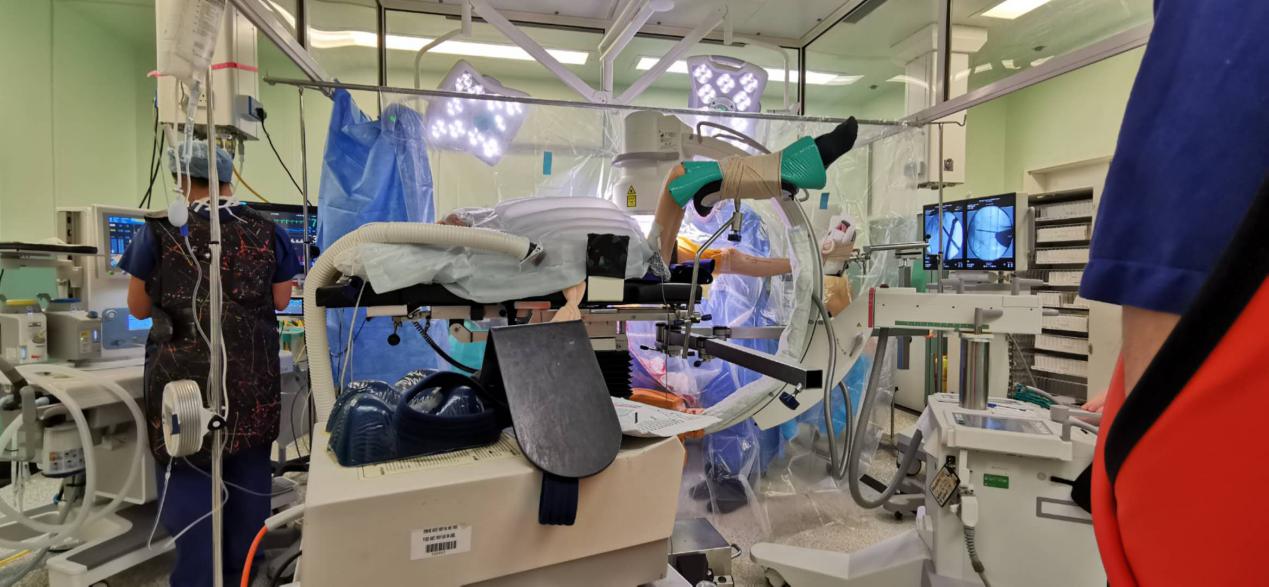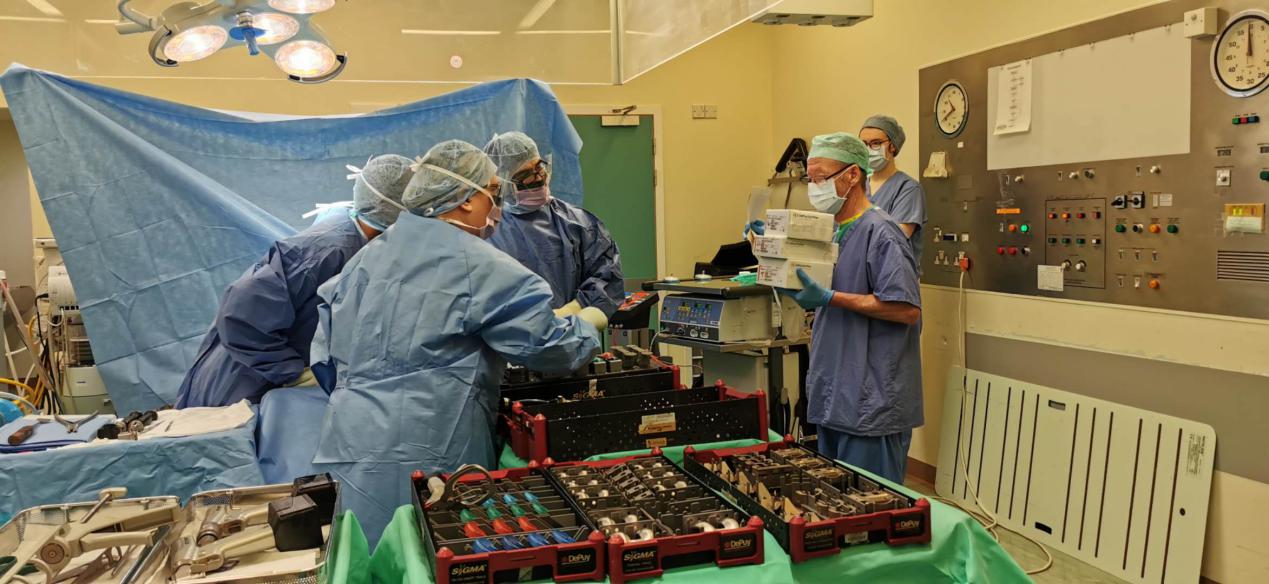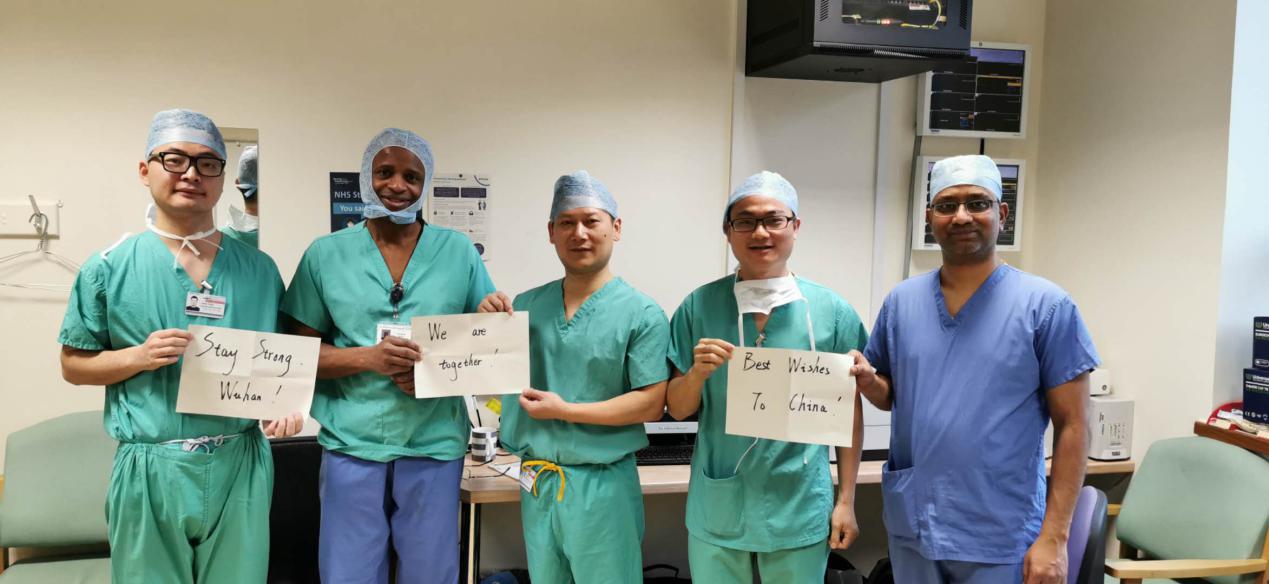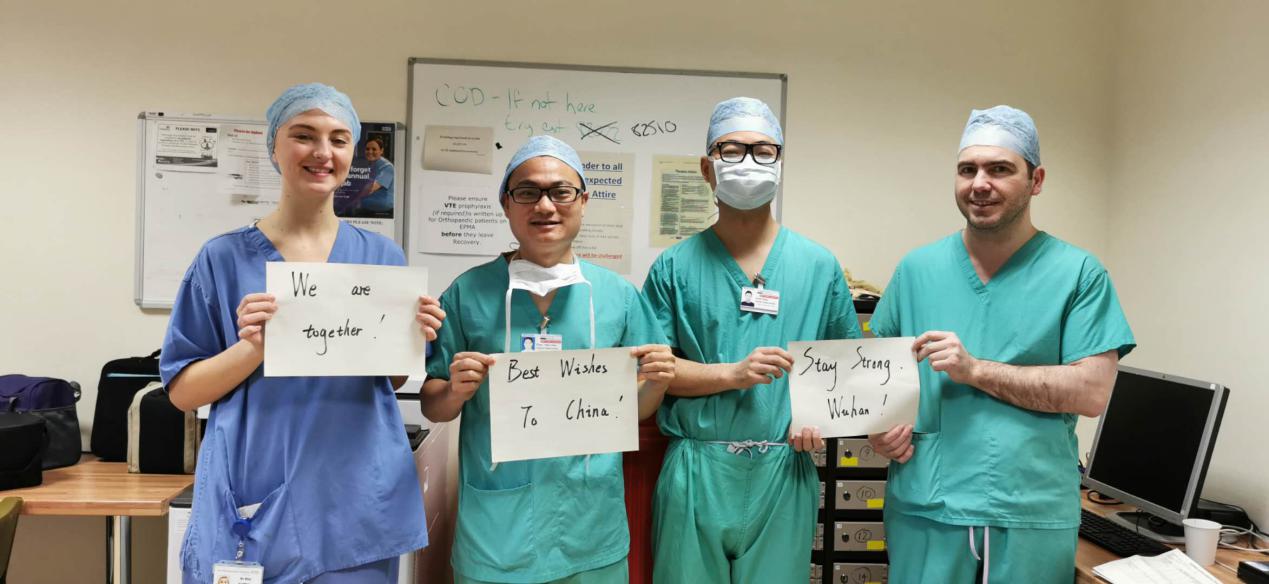In 2020,From Januaryto April, I had the honor to participate in the study program in the UK with eight other doctors from all over the country.Through three months of study, I have seen a lot and learned a lot.Not only improved my clinical expertise , the UK's advanced national health system, department management model, subject cooperation, humanistic care have impressed me .I have a deeper understanding of the latest medical technology, knowledge and management concept of orthopaedics here. Through my daily communication and life experience, I have also improved my oral English ability and felt the British culture. I summarized what I have seen and what I have learned as follows:
Ⅰ. A brief introduction to the hospital
This time I visited three hospitals, each with its own characteristics
Fairfield General Hospital
Location: Bury, Greater Manchester area
Business scope: joint replacement, arthroscopy technology.
History: the hospital originated from the Burley union hospital built in 1905.
It is worth mentioning that bury is also the hometown of John Charnley, the founder of arthroplasty.For a joint surgeon to be here, it’s more or less like a pilgrimage.
Sir John Charnley, Senior Medal winner of the British Empire, academician of the Royal College (August 29, 1911-august 5, 1982), is a British orthopedic doctor.He pioneered hip replacement, one of the most common surgeries in the UK and elsewhere in the world, and created the wrightington hip surgery center.He also demonstrated the importance of bone compression in arthrodesis, especially in the knee, ankle and shoulder joints.Now we can still find some theater equipments named by himin Fairfield hospital.For example, Charnley tube.
Royal Oldham Hospital
Location: Oldham, Greater Manchester area
Business: orthopaedic trauma, ankle, minor joint replacement and arthroscopy (trauma / infection)
History: the hospital originated in 1870 as the Alderman Union Hospital,
On July 25, 1978, it was the birthplace of Louise Brown, the world’s first successful IVF "in vitro baby".
The hospital specializes in obstetrics and Gynecology and emergency business, and the trauma is mostly single trauma.
Salford Royal Hospital
Location: Salford, Greater Manchester area
Business scope: trauma orthopedics (complex injury, acute and severe), external ankle, a small amount of joint replacement and arthroscopy (trauma / infection)
Salford Royal NHS Foundation Trust operates Salford Royal Hospital.It is one of the best performing trusts in the UK.
It was named one of the top 100 trusts for NHS work in 2015 by the Journal of health services.After an inspection in August 2015, the trust was one of only three that the UK nursing quality board rated "excellent.".In April 2016, the trust was named the highest digital maturity index institution in the NHS.
2016In September, NHS England selected the trust as one of 12 global digital examples.
There are some differences between the hospital and Oldham’s treatment scope. After asking, we know that patients with severe and complex injuries will be sent to Salford first.Oldham deals with single fractures and injuries.
All three hospitals belong to the northern Care Alliance, led by Salford hospital, where we spend the most time.
There is a clear division of labor among hospitals in the UK. Even general hospitals have their own specialties.In fact, this is more conducive to the integration and distribution of medical resources.It is also conducive to the development of specialty.
2、British pride - NHS
The NHS is a very proud medical system for the British people. All the people - including foreigners who come here to study and settle down, to see a doctor, take medicine and do surgery - are free (now the overseas students have to pay for it). There are few countries that dare to commit to it. For many British people, the NHS is the most proud asset of the country.I used to think that only taxpayers could use it, but in fact, they told me that even people without jobs, vagabonds and prisoners could enjoy free medical services.
Even at the opening of the 2012 London Olympic Games, Britain put "sickbeds" on the stage, let "doctors", "nurses" and "patients" sing and dance to show the style of the British medical system, and let thousands of medical workers put out huge letters of NHS.
The NHS was established in England in 1948. The NHS includes two levels of healthcare:
The first level is community-based primary medical care, which consists of family clinics and community clinics, mainly providing some primary medical services and private health services for community residents.It is the main body of the NHS, and 75% of the NHS funds are used for this part;
The second level is the second level medical treatment which is mainly based on hospital services, which is in the charge of professional doctors in various departments, mainly dealing with some major accidents and emergency patients, or receiving patients referred by family doctors.The referral system is very strict. When referring patients, the general practitioner or specialist’s referral letter (email) must be sent.
Primary health care is through the community clinic, which takes the general practitioner as the core and consists of GP, nurses, health care as sisters, practice manager, receptionist and other personnel to form a general practice team.Generally speaking, the general practice team has 20-22 members / 10000 residents, including 4 general practitioners, 4-5 nurses, 2 health management assistants, 1 manager and 10 receptionists.Each resident can choose a general practice and sign a contract with it. In addition to the emergency treatment, the resident should first make an appointment with his own general practitioner.The general practitioner decides the treatment plan of the patient or transfers the patient to the superior hospital, and takes charge of the community management after the patient leaves the hospital.Generally speaking, only 10% of cases are transferred from general practitioners to hospitals.At present, general practitioners mainly contact patients through consulting rooms, telephone inquiries, family visits, email and other ways.
The quality of general practitioners is guaranteed.The number of general practitioners accounts for half of the doctors in the UK. It is not easy to become a general practitioner in the UK. It requires five years of medical school study, one year of clinical practice, two years of hospital specialized training, one year of general practice training and passing the examination of the Royal College of general practitioners.And the salary of general practitioners is very competitive, even higher than that of specialists. The annual income of general practitioners is about 116000, and that of specialists is about 106000.General practitioners sign contracts with NHS, and their income comes from two major sources. According to the "quality and effect agreement", the quality of medical service, organization level, patient experience and other factors are taken into account according to the points, so that general practitioners have the opportunity to obtain more income by providing high-quality medical services.This part of income accounts for about one third of the general practitioner’s income.The second part: according to the cost of the contract head, the factors such as age, gender, incidence rate, regional mortality rate, and whether the area is remote or not will be considered.Doctors earn between £ 100 and £ 150 a year from each contracted resident, with an average of 1600 general practitioners contracted.This part of the income accounts for about 2 / 3 of the general practitioner’s income.
Disadvantages: the same problems exist in the countries with universal health insurance. The medical expenses are paid by the government, which brings heavy economic pressure to the government.In order to save money and reduce personnel, the level of diagnosis and treatment in the NHS system seems to bereduced.
Slow medical treatment is one of the most criticized aspects, such as artificial joint replacement for osteonecrosis of the femoral head, which is likely to be scheduled to 18 weeks later.Many of the doctors we contacted had their operations scheduled after three months.Many foreign students told us some stories, such as a small lump at the back of the neck. it took thepatient three days to see the GP first, and then a week to wait for the blood test result.After getting the result, hecouldn’t go back to the doctor immediately, but make an appointment for GP again, and it took another week.After reading the blood test results, GP suggested B ultrasound, and then about half a month later, in a hospital 5km away he did color ultrasound.In the end , the doctor told him
It’s just a small lipoma and you can go home.Lee Kuan Yew, former Prime Minister of Singapore, has also publicly criticized the NHS for its lack of timely and effective treatment in the UK.
In fact, the local people also think that the efficiency is too low. Like such messages on the message board of failfield hospital.
The second is the shortage of human and medical resources.
The NHS covers the whole national spending. Even if the government pays for it, the annual deficit is shocking.Many Americans and people from other European countries come to the UK for treatment because they can't afford to pay for the medical cost in their own country.Which also increases the financial burden and is one of the reasons for the brexits.The government wants to save money.Medical equipment and medical treatment cannot be cut down by law, so it can only be cut from the income and working hours of medical staff.For some young doctors, this is more obvious and there are many objections.In the end, there are fewer and fewer people studying medicine in the UK, and manydoctors have gone to America and other countries with bettersalary.Britain had to find doctors from cheap European countries and India.In Fairfield and Oldham, there are many doctors in India, almost all of them.In Salford, there are fewer doctors from India and more light colored people , but there are only three British doctors in orthopaedics.There are also many Filipinos, poles and Spaniards among the nurses.There were not enough inpatient beds. For example, before the outbreak of the new crownavirus, there were only more than 4000 adult ICU beds in the UK, 80% of which were in use.The current situation of the shortage of medical resources in the UK is the current predicament of NHS, which may also be the reason for the concept of "herb immunity".
Ⅲ. My work life
1Morning shift and casestudywithimages
Every morning at 8 o‘clock, the morning shift will be conducted in the Department, presided over by the consultant on duty and reported by the residents.Which is divided into two parts: the surgery patients of the day
and inpatients.Different from that in China, the operating room staff such as anesthesiologists, scrub and circulation nurses and instrument manufacturers will also participate.Sometimes doctors and nurses in ICU also participate.They will discuss the patient’s general condition, operation plan, equipment and other details .
2Ward round
After the shift, the consultant on duty will take the resident doctors to check the patients, because the patients are scattered in intensive care unit, general ward, postoperative ward and other places, and there are patients in other departments but with orthopedic conditions, often have to run a lot of wards .The ward nurses will participate in the ward round, and communicate with the doctors about the patients.Consultant usually takes a recording pen and dictates important contents. Resident doctors often push mobile computers to run with them. If doctors have any orders, they will operate it on computer right then and make simple records.In addition to the regular content, they also record the psychological state of patients, such as whether they are anxious or crying.They pay great attention to privacy when they check rooms, and usually pull the curtain up. If we participate in the round, they will ask for the patient’s consent first.They pay great attention to hand hygiene when they operate. The sleeves should be rolled over the elbows. They will wash their hands or use hands-free disinfection after contacting the patients.But no matter it’s blood drawing or physical examination, they won’t wear a hat or mask.
3.Clinic
Every day, The list of patients with GP appointment will go through the doctor’s triage first. In addition to clinic, they will be allocated to outpatient observation, gypsum room, inpatient department and other places.
The majority of outpatients are who with chronic diseases or come back for postoperative reexamination. Generally, A doctor see about20 patients a day, and the time is controlled by the doctor. One companion is allowed to come in with the patient.Before treatment, the doctor will know the condition of the patient through the email sent by GP, and after treatment, the doctor will also send the treatment opinions to GP through voice and email.Doctors tend to be friendly with patients, just like friends and neighbors.When the patient come in, The doctor will say hello and showhim the seat,and also introduce me to the patient. The doctor even talked about things besides the illness. One day a 70 year old man with hip joint disease came here. The outpatient doctor made an operation appointment for him and talked about his family. The old man said that his wife died last year. Now he lives with his daughter and has no friends.The doctor has been encouraging him to go out of the house and meet more friends in church all the time. Maybemore than 20 minutes, just like a friend chatting, without any impatience. I think that he has done a very good job in humanistic care.Once with a consultantspecilited in foot and ankle surgeon, he used his spare time in the clinic to write rehabilitation treatment for Achilles tendon injuryed patients. He weighed every word carefully.He told me that because the reading level of most local residents is not high, he should try to make the things for the patients easy to understand without ambiguity. The pointis not to finish he work,but to help others .This kind of work attitude from the perspective of patients makes me very touched.
4.Operation room
The operating room called theater here is where we spent the most time.After the shift, the surgeon will go to the ward with the anesthesiologist to see today’s key surgical patients.After that, he will enter the operating room and hold a short meeting with all the operating group such as the team of surgeons, anesthesiologists, scrub
And circulation nurses.They discussabout the general condition of patients today, the way of operation, the past history, the equipments expected to be used in the operation, the operation time, and the operation sequence.Even as a visitor, I were asked to join it, and the visitor’s name was written on the blackboard like a member of the group. The operating room is like a suite. The small rooms around are restroom, anesthesia room, equipment room and dirt room, with clear functional division and high efficiency.
Anesthesiologists operate in the anesthesia room, they do lumbar anesthesia with sitting position, usually assisted by nerve block anesthesia.Disinfection before anaesthesia is also done with disinfectant spray.They wear gloves, but rarely masks.They are very humane. They measure planes with small spray. Some doctors will disinfect the patientfor the first time in the anesthesia room.
Once anesthesia is ready, the door will open to the operating room, which is very convenient.At this time, the chief surgeon and a assitant will disinfect and spread the towel together.The operation is basically the same as ours, the principle is the same, but they may be more principled than ours, and there are some different places, for example, their surgical incision is too large, but it may be related to the patient’s obesity.For another example, I have seen them use the lateral position for hip joint replacement, only two people can complete the operation, but they need a set of special equipments.C-arm is widely used in orthopedic operation. Someone is speciallyarranged for the use of the C-arm, which is rotated every four hours.Every small step will be checked with a C-arm machine.A 2-hour operation may require more than 100 times X-ray.All nurses and anesthesiologists would wear lead clothes, and no one showed any concern about radiation.But through the monitoring of C-arm, the operation effect is very good indeed.Because the treatment is free of charge, so in terms of surgical consumables, surgeons have the right to decide, generally give patients the latest and best things they can provide, as long as patients need, or even a variety of consumables together, basically without considering the cost for But I also feel a little worried aboutthe NHS funding.


Patients with joint replacement do not have drainage tube, but they will use small negative pressure dressing, and their patients will have little bleeding after operation. After operation, they will use elastic bandage to compress and bandage, and remove it the next day.Most people can go home the next day.Because GP and community health personnel will deal with the follow-up problems such as removing the thread and changing the dressing.
Everyone is very kind here. They will answer you any qustions as they can .What impresses me is their clear clinical thinking. For example, in one tibial fracture operation, the chief surgeon implanted allogeneic bone to the patient because of certain bone defect.After the operation, I asked him whether to consider using autogenous bone.He gave me a very detailed explanation of the properties of bone graft materials, such as osteogenic ability, osteoinductive ability and osteoconductive ability. In this patient, this case had a part of defect after reduction due to bone compression, not bone nonunion, so he chose the allogeneic bone with only osteoconductive ability but a certain force-bearing ability. He was afraid that I could not fully understand so drew a picture.In fact, the answer is very simple, but we often make choices directly, and rarely comb in our minds as seriously as he does.Maybe this is the difference of clinical thinking.
Tea, coffee, milk and sometimes cakes are provided free of charge in the coffee room of the theater. There are also refrigerators and microwave ovens for the staff.This is the place where the operating staff rest and chat. We often chat with the operating doctors here to discuss the differences betweenthe Chinese and English medical treatment.They also talked about a lot of non medical things. They told us about their tourism to China, the experience of supporting public welfare abroad, and even talked about their values attitude and families. They were very happy and willing to share.There are many doctors here, of different colors and nationalities, but there is no expected gap in communication.


When we arrived in Britain ,China was fighting with the coronavirus.People in the UK supported us a lot and we appreciate it.At the time of our departure, the UK was facing the same problem. They were also faced with the dilemma of shortage of materials. But the NHS medical staff, like our Chinese medical workers, were real heroes.I wish them safe and security, and I wish the epidemic in the UK and around the world to subside as soon as possible.
In fact, the exchanges between countries are increasingly close, and the gap between borders is not so obvious any more.Common development, common prosperity and win-win cooperation are the pathway of our human development!